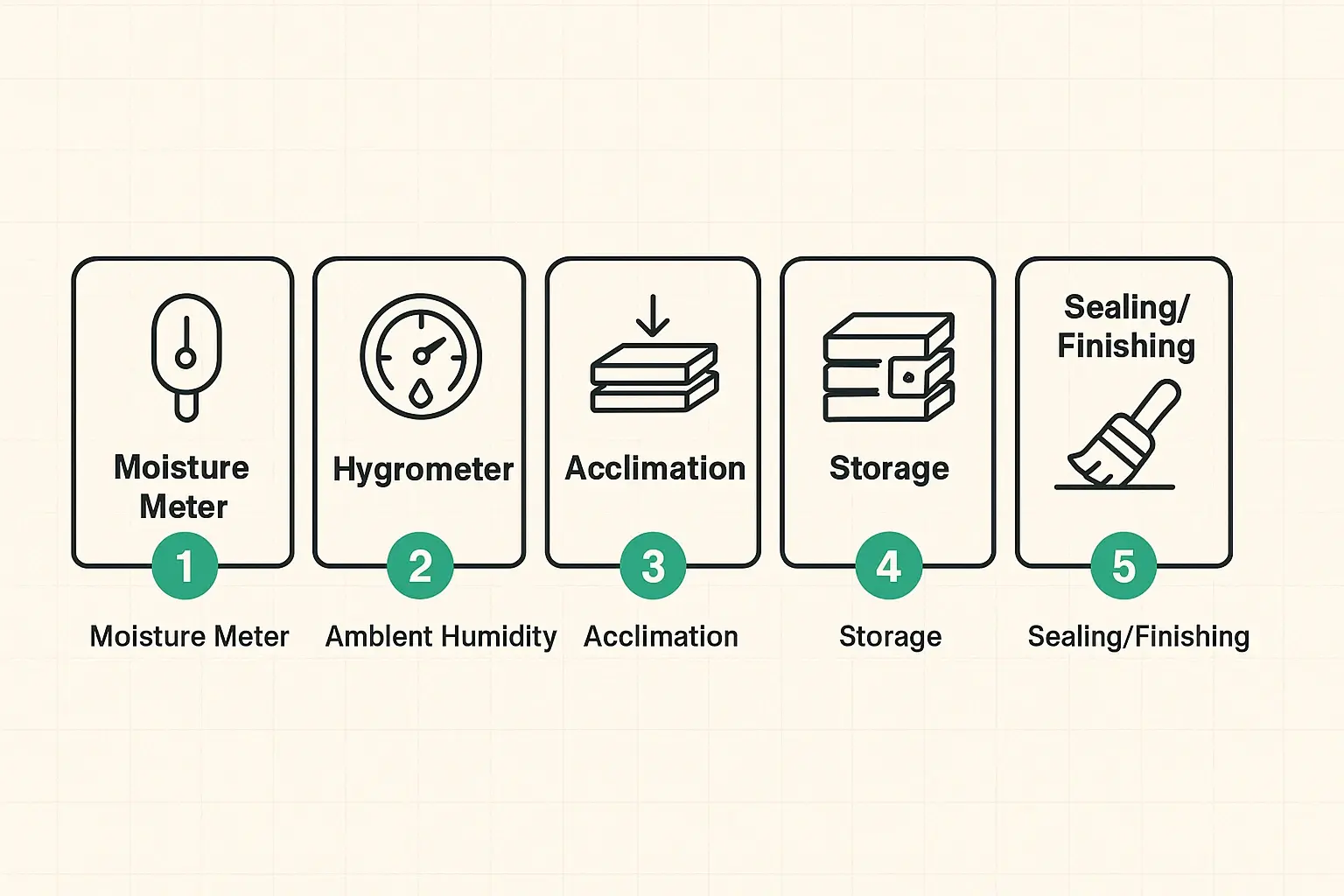Ever finish a beautiful woodworking project, only to find a few months later that a cabinet door won’t close, a tabletop has developed a subtle wobble, or fine cracks have appeared in a perfect joint? It’s a frustrating experience familiar to woodworkers of all levels. The culprit is often an invisible force you can’t see but is constantly at work: humidity.
Wood isn’t a static material; it’s a natural, porous substance that behaves a lot like a sponge. It breathes, absorbing and releasing moisture from the air around it. This constant exchange is the root cause of almost all wood defects. But understanding and controlling this process isn’t complex—it’s the key to transforming your woodworking from a game of chance into an art of precision.
The Secret Life of Wood: Why It Moves
To stop wood from warping, you first have to understand why it moves. Wood is a hygroscopic material, a scientific term that simply means it strives to be in balance with the humidity of its surrounding environment. When the air is humid, wood absorbs moisture and swells. When the air is dry, it releases moisture and shrinks.
This balancing act is called reaching Equilibrium Moisture Content (EMC). Think of EMC as wood’s “happy place,” where it’s no longer trying to absorb or release moisture because it’s in perfect harmony with the air. The problem starts when the humidity in your workshop, storage area, or the final home of the piece fluctuates dramatically, forcing the wood to constantly chase a new state of equilibrium.
This isn’t just a surface-level issue. Moisture moves deep within the cellular structure of the wood, causing physical changes that create immense internal stress.

As the diagram shows, water exists in wood in two ways: as “free water” in cell cavities and “bound water” absorbed into the cell walls themselves. Wood only begins to shrink once all the free water is gone and the bound water starts to leave the cell walls—a point known as the Fiber Saturation Point. It’s this shrinking and swelling of the actual wood fibers that causes the powerful forces that lead to warping and cracking.
The Science of Stress: An Unbalanced Force
If wood swelled and shrank uniformly, like a perfectly expanding balloon, it wouldn’t be much of an issue. But wood is not uniform. This is the single most important concept to grasp.
The “aha moment” for many woodworkers is understanding anisotropic shrinkage. It sounds complicated, but it just means wood shrinks and swells by different amounts in different directions:
- Tangentially (along the growth rings): This is where the most movement occurs.
- Radially (across the growth rings): It moves about half as much in this direction.
- Longitudinally (along the grain): Movement is almost negligible.
This uneven movement is the direct cause of warping. A flatsawn board, for example, will “cup” because the side nearest the bark (with more tangential grain) shrinks more than the side nearest the tree’s center. The wood is literally pulling itself into a new shape. When this internal stress becomes too much for the wood fibers to handle, especially if the moisture changes too quickly, they pull apart and create cracks.
These forces manifest in several distinct ways, each with a unique name and shape.

Understanding these types isn’t just for identification; it helps you diagnose the root cause. A twisted board might have come from a tree with spiral grain, while a cupped board is almost always a result of unbalanced moisture on opposite faces.
Mastering Your Environment: A Practical Guide to Humidity Control
Knowing the science is half the battle. The other half is taking control of your environment. For most indoor wood products like furniture and cabinetry, the ideal relative humidity (RH) is between 35% and 55%. Maintaining this stable range is the most effective way to prevent defects.
A professional workflow for managing humidity involves a few key tools and consistent practices.

1. Measure and Monitor
You can’t control what you don’t measure.
- Hygrometer: This simple tool measures the relative humidity in your air. Place several in your workshop and storage areas to monitor conditions constantly.
- Moisture Meter: This device measures the actual moisture content inside a piece of wood. It’s essential for checking new lumber and ensuring a board is ready to be worked.
2. Acclimate Your Material
Never start working on wood the day it arrives in your shop. It needs time to acclimate—to reach its Equilibrium Moisture Content with your specific environment. Stack the boards with spacers (“stickers”) between each layer to allow for even air circulation on all faces. This process can take a week or more, depending on the wood’s starting moisture content.
3. Store Smarter, Not Harder
Proper storage prevents problems before they start. Always store lumber flat on a level surface. Avoid leaning boards against a wall, as this can cause them to bow under their own weight. Keep wood away from direct sunlight, heaters, or vents, which can cause one side to dry out much faster than the other.
4. Understand the Truth About Finishing
A common myth is that polyurethane or varnish completely seals wood from moisture. This is incorrect. Finishes don’t stop moisture exchange; they only slow it down. The most critical rule of finishing is to coat all sides and edges equally. If you only finish the top of a tabletop, the unfinished bottom will absorb and release moisture much faster, causing the board to cup.
Frequently Asked Questions: Your Wood Warping Worries, Answered
What is the ideal humidity for wood?
For most interior applications like furniture, cabinets, and musical instruments, a relative humidity between 35% and 55% is the sweet spot. The key is stability—avoiding wild swings is more important than hitting one perfect number.
Does sealing wood completely prevent warping?
No. Finishes like polyurethane, lacquer, and oils only slow down the rate of moisture absorption and release. This is helpful for managing short-term humidity fluctuations, but it won’t stop wood movement over the long term. That’s why sealing all surfaces evenly is so crucial for balanced moisture exchange.
How long does wood need to acclimate?
There’s no single answer, but a general rule of thumb is one week for every inch of thickness. However, the best way to know for sure is to use a moisture meter. Check the wood every few days until its moisture content holds steady for 2-3 consecutive days.
Can I fix wood that has already warped?
Sometimes, but it’s difficult and often not 100% effective. Methods involving moisture, heat, and pressure can sometimes correct minor warping, but prevention is always the better strategy. For severe warps, the best solution is often to re-mill the piece to be flat, though you will lose some thickness.
Are some wood species more stable than others?
Absolutely. Generally, woods with straight, consistent grain and high density tend to be more stable. Quartersawn and riftsawn boards are significantly more stable than flatsawn boards from the same species because their grain orientation is less prone to distortion from tangential shrinkage.
Beyond Prevention: Building for a Lifetime of Stability
Controlling humidity isn’t just about preventing flaws; it’s about elevating your craft. It’s the invisible element that ensures your work looks as good in ten years as it does the day you finish it. By understanding the science of wood movement and mastering your workshop’s environment, you gain control over your material in a way that sets your work apart.
This knowledge empowers you to select the right wood, store it correctly, and build with techniques that anticipate and accommodate its natural movement. Your joints will stay tighter, your surfaces will remain flatter, and your projects will stand the test of time, proving that the best woodworking happens when skill, artistry, and science come together.




